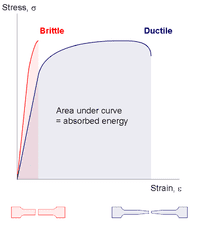 | ||
Toughening
This principle generalizes to other classes of material. Naturally brittle materials, such as glass, are not difficult to toughen effectively. Most such techniques involve one of two mechanisms: to deflect or absorb the tip of a propagating crack, or to create carefully controlled residual stresses so that cracks from certain predictable sources will be forced closed. The first principle is used in laminated glass where two sheets of glass are separated by an interlayer of polyvinyl butyral, which as a viscoelastic polymer absorbs the growing crack. The second method is used in toughened glass and pre-stressed concrete. A demonstration of glass toughening is provided by Prince Rupert's Drop. Brittle polymers can be toughened by using metal particles to initiate crazes when a sample is stressed, a good example being high-impact polystyrene or HIPS. The least brittle structural ceramics are silicon carbide (mainly by virtue of its high strength) and transformation-toughened zirconia.
Contents
A different philosophy is used in composite materials, where brittle glass fibres, for example, are embedded in a ductile matrix such as polyester resin. When strained, cracks are formed at the glass–matrix interface, but so many are formed that much energy is absorbed and the material is thereby toughened. The same principle is used in creating metal matrix composites.
Effect of pressure
Generally, the brittle strength of a material can be increased by pressure. This happens as an example in the brittle-ductile transition zone at an approximate depth of 10 kilometres (6.2 mi) in the Earth's crust, at which rock becomes less likely to fracture, and more likely to deform ductilely (see rheid).
Crack growth
Supersonic fracture is crack motion faster than the speed of sound in a brittle material. This phenomenon was first discovered by scientists from the Max Planck Institute for Metals Research in Stuttgart (Markus J. Buehler and Huajian Gao) and IBM Almaden Research Center in San Jose, California (Farid F. Abraham).
